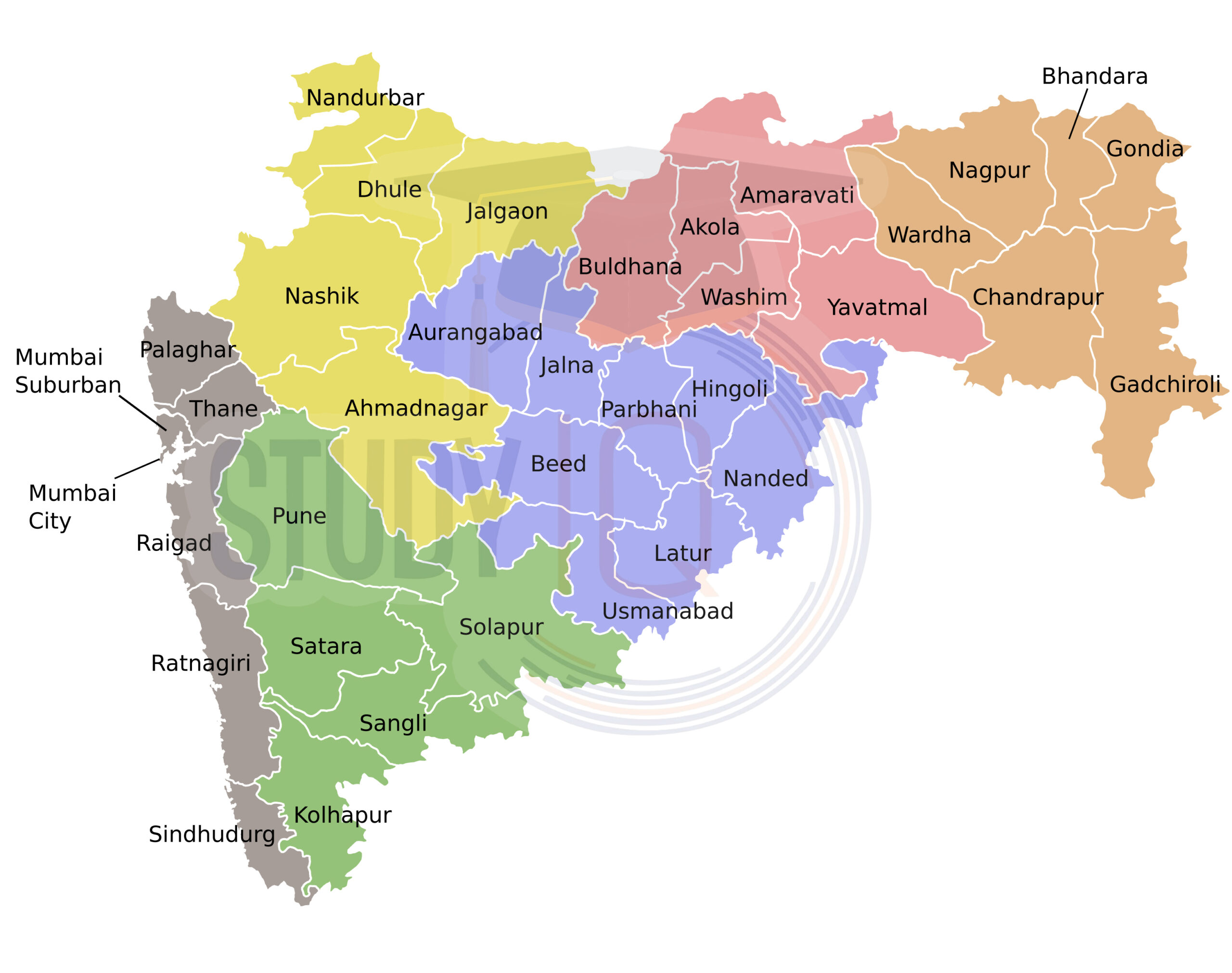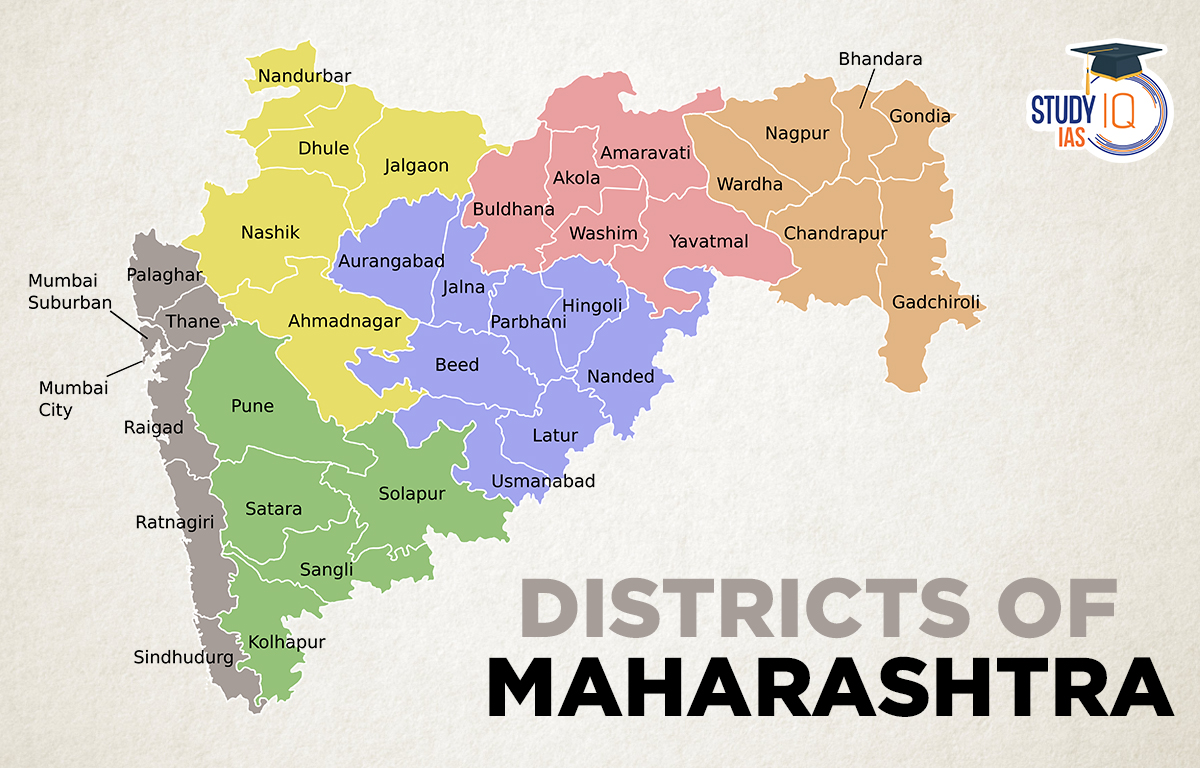Table of Contents
Districts of Maharashtra
Maharashtra, a state in western India, is home to 36 districts. Each district has its unique culture, heritage, and natural beauty that reflects the diversity of the state. The districts of Maharashtra vary greatly in terms of size, population, and economy. From bustling cities to the serene countryside, the districts of Maharashtra offer a glimpse into the state’s rich history, traditions, and way of life.
Whether it’s the bustling metropolis of Mumbai or the picturesque hill stations of the Western Ghats, the districts of Maharashtra have something to offer everyone. The districts of Maharashtra are an integral part of the state’s identity and play a crucial role in shaping its past, present, and future.
Read More: District of Uttar Pradesh
Districts of Maharashtra Map
The map of Maharashtra’s districts is a representation of the state’s geographical and administrative divisions. The map of the Districts of Maharashtra provides a quick and easy reference for anyone looking to explore the state’s different regions, cultures, and attractions.

Read More: Districts of India
List of Districts of Maharashtra with their Importance
| S. No | District | Importance |
| 1 | Ahmednagar | Home to Shirdi Sai Baba Temple, one of the most visited pilgrimage sites in India. |
| Has a rich history dating back to the Maratha Empire, with many forts and historical sites to explore. | ||
| Known for its agricultural produce, including sugar, grapes, and pomegranates. | ||
| 2 | Akola | Known for its textile industry, particularly cotton production and processing. |
| Home to the Akola Fort, a historical monument built by the British in the 19th century. | ||
| The district has a rich cultural heritage, with several fairs and festivals celebrated throughout the year. | ||
| 3 | Amravati | Known for its wildlife sanctuary, the Melghat Tiger Reserve, which is home to several endangered species. |
| Has a vibrant cultural scene, with several cultural and educational institutions. | ||
| Home to the Sant Gadge Baba Amravati University, one of the largest universities in the region. | ||
| 4 | Aurangabad | Famous for the Ajanta and Ellora caves, UNESCO World Heritage Sites. |
| Has a rich cultural history, with several historical sites and monuments dating back to the Mughal era. | ||
| Known for its silk and cotton industries. | ||
| 5 | Beed | Known for its agricultural produce, particularly sugarcane and cotton. |
| Has several historical sites, including the Parli Vaijnath temple and the Kankaleshwar temple. | ||
| The district has a rich cultural heritage, with several fairs and festivals celebrated throughout the year. | ||
| 6 | Bhandara | Known for its wildlife sanctuary, the Nagzira Wildlife Sanctuary, which is home to several endangered species. |
| Has several historical sites, including the Deori Temple and the Bhanpura Fort. | ||
| Home to several industries, including paper mills, glass factories, and rice mills. | ||
| 7 | Buldhana | Known for its agriculture, particularly cotton and soybean production. |
| Has several historical sites, including the Lonar Crater, a unique natural phenomenon. | ||
| The district has a rich cultural heritage, with several fairs and festivals celebrated throughout the year. | ||
| 8 | Chandrapur | Known for its coal mines, which are among the largest in Asia. |
| Has several wildlife sanctuaries, including the Tadoba Andhari Tiger Reserve. | ||
| The district has a rich cultural heritage, with several historical sites and monuments. | ||
| 9 | Dhule | Known for its agricultural produce, particularly onion and cotton. |
| Has several historical sites, including the Songir Fort and the Kapileshwara Temple. | ||
| Home to several industries, including textile mills and power plants. | ||
| 10 | Gadchiroli | Known for its tribal culture and traditions. |
| Has several wildlife sanctuaries, including the Indravati National Park and the Nagzira Wildlife Sanctuary. | ||
| Home to several industries, including bamboo and paper mills. | ||
| 11 | Gondia | Known for its wildlife sanctuaries, including the Navegaon National Park and the Nagzira Wildlife Sanctuary. |
| Has several historical sites, including the Pratapgad Fort and the Suryadeo Temple. | ||
| Home to several industries, including rice mills, sawmills, and bamboo handicrafts. | ||
| 12 | Hingoli | Known for its religious sites, including the Aundha Nagnath Temple and the Mallinath Digambar Jain Temple. |
| Has a rich cultural heritage, with several fairs and festivals celebrated throughout the year. | ||
| Home to several industries, including cotton and oilseed processing. | ||
| 13 | Jalgaon | Known for its agriculture, particularly banana and cotton production. |
| Has several historical sites, including the Mehrun Lake and the Ajanta Caves. | ||
| The district has a rich cultural heritage, with several fairs and festivals celebrated throughout the year. | ||
| 14 | Jalna | Known for its historical sites, including the Daulatabad Fort and the Kali Masjid. |
| Has a rich cultural heritage, with several fairs and festivals celebrated throughout the year. | ||
| Home to several industries, including cotton ginning and pressing. | ||
| 15 | Kolhapur | Known for its cultural heritage, including the Kolhapuri chappal and the Mahalakshmi Temple. |
| Has several historical sites, including the Panhala Fort and the Rankala Lake. | ||
| Home to several industries, including sugar mills and textile mills. | ||
| 16 | Latur | Known for its historical sites, including the Ausa Fort and the Udgir Fort. |
| Has several wildlife sanctuaries, including the Tarni-Karanja-Mahakali Wildlife Sanctuary. | ||
| The district has a rich cultural heritage, with several fairs and festivals celebrated throughout the year. | ||
| 17 | Mumbai City | Known as the financial capital of India and the center of the country’s film industry. |
| Has several historical and cultural landmarks, including the Gateway of India and the Elephanta Caves. | ||
| Home to several industries, including finance, media, and entertainment. | ||
| 18 | Mumbai Suburban | Comprises the suburban areas surrounding Mumbai City and is home to several residential and commercial neighborhoods. |
| Has several beaches, including the Juhu Beach and the Versova Beach. | ||
| Home to several industries, including information technology and textiles. | ||
| 19 | Nagpur | Known as the orange city of India and is a major center for the production and export of oranges. |
| Has several historical and cultural landmarks, including the Deekshabhoomi and the Sitabuldi Fort. | ||
| Home to several wildlife sanctuaries and national parks, such as the Pench Tiger Reserve and the Tadoba Andhari Tiger Reserve, known for their rich biodiversity and wildlife conservation. | ||
| 20 | Nanded | Known for its religious significance, particularly the Hazur Sahib Gurudwara, one of the most important pilgrimage sites for Sikhs. |
| Has several historical sites, including the Kandhar Fort and the Masjid of Biloli. | ||
| The district has a rich cultural heritage, with several fairs and festivals celebrated throughout the year. | ||
| 21 | Raigad | Known for its historical significance as it was the capital of the Maratha Empire under Shivaji Maharaj. |
| Has several beaches and tourist attractions, such as Alibaug, Kashid, and Murud-Janjira. | ||
| Home to the Raigad Fort, which is a UNESCO World Heritage Site and a popular tourist attraction. | ||
| 22 | Ratnagiri | Known for its picturesque beaches, natural beauty, and historical significance. |
| Famous for its Alphonso mangoes, which are exported worldwide. | ||
| Home to the Ratnadurg Fort, the Thibaw Palace, and several beautiful temples and shrines. | ||
| 23 | Sangli | Known for its fertile agricultural land, sugarcane production, and grape vineyards. |
| Home to several beautiful temples and historical landmarks, such as the Sagareshwar Wildlife Sanctuary and the Irwin Bridge. | ||
| Has several industries, including sugar factories, textile mills, and chemical manufacturing. | ||
| 24 | Satara | Known for its beautiful landscapes, valleys, and hills. |
| Has several historic sites, such as the Ajinkyatara Fort and the Kaas Plateau. | ||
| Home to several major industries, including sugar, textiles, and leather. | ||
| 25 | Sindhudurg | Known for its beautiful beaches, historic forts, and ancient temples. |
| Famous for its Malvani cuisine, which is known for its spicy and coconut-based curries. | ||
| Has several popular tourist attractions, including the Sindhudurg Fort, Tarkarli Beach, and Devgad Beach. | ||
| 26 | Solapur | Known for its textile and sugar industries. |
| Has several historic landmarks, such as the Siddheshwar Temple and the Hutatma Smarak. | ||
| Home to several wildlife sanctuaries, such as the Great Indian Bustard Sanctuary and the Solapur Bird Sanctuary. | ||
| 27 | Thane | Known for its proximity to Mumbai and its beautiful natural scenery, including hills, lakes, and forests. |
| Has several historic sites, such as the Elephanta Caves and the Kelva Fort. | ||
| Home to several industries, including manufacturing, IT, and pharmaceuticals. | ||
| 28 | Wardha | Known for its association with Mahatma Gandhi, who established his ashram here during the freedom struggle. |
| Has several important educational institutions, such as the Mahatma Gandhi Antarrashtriya Hindi Vishwavidyalaya. | ||
| Home to several industries, including textiles, agro-based industries, and paper manufacturing. | ||
| 29 | Washim | Known for its religious significance, as it is home to several important temples and shrines, such as the Shree Vithoba Temple and the Jyotirlinga Temple. |
| Has several historic sites, such as the Nrusimha Mandir and the Hanuman Temple. | ||
| Has several industries, including agriculture, textiles, and mining. | ||
| 30 | Yavatmal | Known for its cotton and textile industries. |
| Has several important wildlife sanctuaries and national parks, such as the Tipeshwar Wildlife Sanctuary and the Melghat Tiger Reserve. | ||
| Home to several historic landmarks, such as the Kalamb Temple and the Murti Devi Temple. | ||
| 31 | Nandurbar | Home to the Adivasi tribe and the Toranmal hill station. |
| Situated on the banks of the Tapi river and home to the Dandpaneshwar temple. | ||
| Rich historical and cultural heritage, with landmarks like the 13th-century Kedareshwar temple. | ||
| 32 | Nashik | Major wine-producing region in India, with vineyards like Sula and York. |
| Home to several ancient Hindu temples like Trimbakeshwar and Kalaram Temple. | ||
| Famous for Kumbh Mela pilgrimage and the Pandavleni Caves. | ||
| 33 | Osmanabad | Rich cultural heritage and historical monuments like the Naldurg Fort. |
| Home to ancient temples like Tuljabhavani Mandir and Dharashiv Caves. | ||
| Important agricultural district with crops like cotton, sugarcane, and soybean. | ||
| 34 | Palghar | Beautiful beaches like Kelva and Mahim and historical landmarks like the Kelva Fort. |
| Industrial district with small and large-scale industries like the Tarapur Atomic Power Station. | ||
| Popular weekend getaway destination, with attractions like the Vajreshwari hot springs. | ||
| 35 | Parbhani | Known for its rich agricultural heritage and the Paithan dam. |
| Important historical landmarks like the Hazrat Turabul Haq Dargah and the Kedareshwar temple. | ||
| Home to several institutions of higher education like Dr. Babasaheb Ambedkar Marathwada University. | ||
| 36 | Pune | Cultural capital of Maharashtra, with landmarks like the Shaniwar Wada and Aga Khan Palace. |
| Renowned institutions of higher education like Savitribai Phule Pune University and IISER Pune. | ||
| Important hub for IT and automobile industries, with companies like Infosys and Tata Motors having a presence here. |
Read More: Districts of Telangana


 Miss Universe Winners List From 1952 to ...
Miss Universe Winners List From 1952 to ...
 Significance and History of Diwali Festi...
Significance and History of Diwali Festi...
 Asia Cup Winners List (1984–2025): Ind...
Asia Cup Winners List (1984–2025): Ind...

























